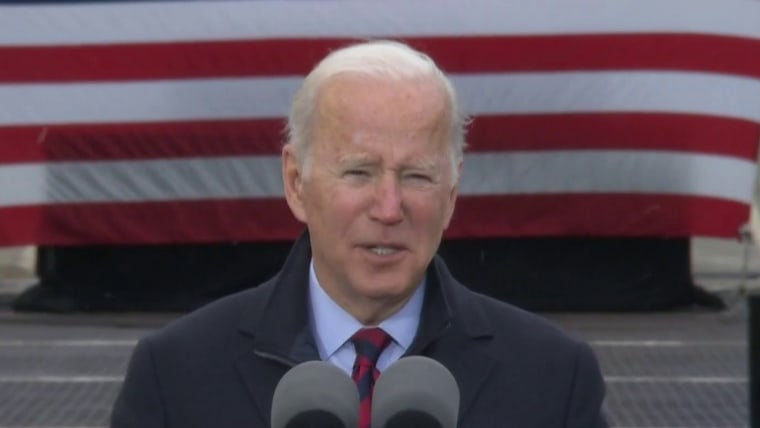For climate experts and policymakers, $1 trillion is just a start.
As the U.S. seeks to prove it’s serious about its international climate commitments, the focus now is on whether the Biden administration can pass its $2 trillion spending bill, which includes $555 billion to fight climate change and could be the new cornerstone of federal climate policy.
The $1 trillion bipartisan infrastructure bill passed by Congress this month already commits historic levels of funding for climate projects. But experts say the U.S. won’t reach its climate goals or restore its international credibility unless the administration can pass its Build Back Better bill, which features a variety of other climate initiatives and calls for significant investments in clean energy.
The sizable dollar figures offer a sense of the scale of the challenge the U.S. faces in rolling back its emissions, undoing some environmental damage and preparing for more climate-related natural disasters.
“These are the biggest pieces of climate policy legislation the U.S. has seen in a decade,” said Katharine Hayhoe, a climate researcher and the chief scientist at The Nature Conservancy. “The faster we can act, the better off we’ll be, because we’re already late to the table. The time for half-measures was 30 years ago.”
The provisions are particularly timely as the U.S. tries to move past President Donald Trump’s efforts to unwind significant climate efforts by pulling the country out of the Paris Agreement and killing a slew of environmental protections.
President Joe Biden’s participation in COP26, the worldwide summit on climate policy held in Scotland this month, marked the U.S.’s return to global climate negotiations after Biden rejoined the Paris Agreement in January.
U.S. officials at the conference faced an uphill fight to restore international trust in the U.S.’s climate commitments.
As part of Biden’s updated COP26 pledge, the U.S. aims to slash greenhouse gas emissions at least 50 percent below 2005 levels by 2030. David Waskow, the director of the International Climate Initiative at the World Resources Institute, a Washington-based nonprofit research organization, said the goal was “quite ambitious,” adding that the U.S.’s return to international diplomacy on climate change was significant in itself.
“It’s critical to remember that if you go back a year, there wouldn’t have been a U.S. administration that was engaging constructively in these talks,” Waskow said.
While Biden went to COP26 projecting a new tone, the country’s ability to deliver on its 2030 targets is likely to hinge on the success of infrastructure projects and the outcome of the Build Back Better Act, which, if it passes, could wind up being significantly scaled back.
Both are needed to meet the country’s emissions goals, experts say.
The infrastructure bill will harden the country’s roadways and ports to better deal with the effects of climate change, but it offers comparatively less to reduce greenhouse gas emissions that will intensify climate change.
In Washington state, for example, projects funded by the bill are expected to help re-engineer roads and bridges for a warmer and wetter future, boost transit projects like light rail and improve stream passageways for fish struggling with climate change.
Flooding this month following record rainfall in parts of Western Washington sent landslides onto the state’s most-traveled interstate and poured floodwaters into small towns — a preview of what climate scientists expect more often.
“All of the money to some degree has a bearing on our ability to be more resilient,” said Gov. Jay Inslee, a Democrat who ran a 2020 presidential campaign centered on climate action. “But it doesn’t get us close to what we need to reduce the rate at which these floods get worse.”
The infrastructure bill will spend about $70 billion to upgrade the country’s electricity grid and $7.5 billion more to build a network of charging stations for electric vehicles, which could hasten the transition away from gas-guzzling cars.
But from Inslee’s perspective, it offers only a “step” toward progress, whereas the Build Back Better bill’s clean energy investments would be “transformative.”
The act calls for spending more than a half-trillion dollars on clean energy investments, incentives and tax credits to shift the economy away from fossil fuels.
Analysis by the independent Rhodium Group says the budget bill could reduce U.S. carbon emissions by nearly a gigaton, which would be about equivalent to removing the yearly emissions of light-duty vehicles from U.S. roadways. Combining the budget bill with the infrastructure bill and state and local regulations, the U.S. could meet Biden’s 2030 emissions target, with the budget bill representing the “lion’s share” of reductions, the analysis says.
“There’s no question that the Build Back Better Act is crucial. It can drive the U.S. a substantial distance toward achieving the 50 to 52 percent reduction,” Waskow said.
The legislation also prioritizes environmental justice by earmarking 40 percent of the overall benefits of investment for disadvantaged communities.
The infrastructure bill committed $216 million to the Bureau of Indian Affairs specifically for climate resilience projects in Indian County, according to the White House. About $130 million of the money will go toward relocation projects for tribes that need to move away from climate hazards.
Some tribal communities — including many in Alaska — may need to move in the coming decades because of climate hazards like coastal erosion, flooding and thawing permafrost, the Government Accountability Office said in a report last year.
Fawn Sharp, the vice president of the Quinault Indian Nation, whose seaside villages in Washington state face threats from tsunamis, coastal erosion and rising sea levels, estimated that her community needs at least $150 million to complete plans to uproot for higher ground — at least $20 million more than what is committed to all tribes.
“It’s unprecedented and a level of funding we’ve not seen in our lifetime,” Sharp, the president of the National Congress of American Indians, said broadly of the infrastructure bill. “While this is significant, we have a long way to go to restore tribal nations.”
Climate scientist Jonathan Foley sees reasons to feel encouraged even beyond what happens in Congress.
“Sometimes we get obsessed with these large policies, as if they’re going to save the world, but the real work of reducing emissions and addressing climate change is often lots of invisible forces working every single day,” said Foley, the executive director of Project Drawdown, a nonprofit organization that provides resources about climate solutions.
Market forces and technological advances have, for example, helped drive down the cost of solar and wind power, which in turn is contributing to the shift away from fossil fuels. Vocal opposition, led in particular by young activists, is also pressuring government officials to act, Foley said.
“Good policymakers can accelerate change, but activism, technology and markets are already getting things done on their own,” he said. “That has nothing to do with who is in the White House.”
"back" - Google News
November 28, 2021 at 07:33PM
https://ift.tt/3cTOSAP
Climate change efforts set for big boost if Build Back Better bill passes - NBC News
"back" - Google News
https://ift.tt/2QNOfxc
Shoes Man Tutorial
Pos News Update
Meme Update
Korean Entertainment News
Japan News Update
Bagikan Berita Ini
















0 Response to "Climate change efforts set for big boost if Build Back Better bill passes - NBC News"
Post a Comment